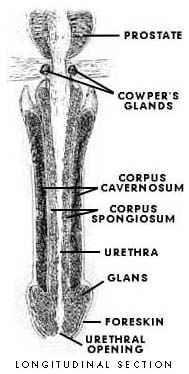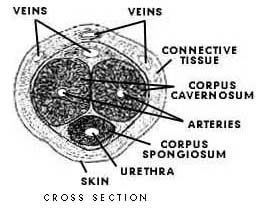By M.J. Ecker
IF you think the penis is just a balloon of skin that fills up with blood when you get an erection, you're quite mistaken. Or, at least, that's an oversimplified way of looking at it. The mechanisms for erection are complex and interesting. First, let's take a look at the various structures that make up the penis.
There are three erectile structures inside the penis; when the penis is soft (or "flaccid"), these are like cylinders of sponge – except this kind of sponge is normally collapsed and expands only when something (blood) fills it. One of the cylinders is located near the base of the penis, surrounding the urethra; it's the corpus spongiosumor "spongy body." The other two are located on each side of the upper part of the penis; each of these is called a corpus cavernosumor "cavernous body." The corpora cavernosa (that's the plural) are largely responsible for the hardness of the erect penis, as the corpus spongiosum is somewhat softer, which you can verify yourself. (Note in the picture to the right that most of the penis head, or glans, is just an enlargement of the corpus spongiosum.) Running through the center of each corpus cavernosum is one of the two major arteries of the penis; blood returns from the penis to the heart through the veins, located closer to the skin. The Cowper's glands secrete the pre-ejaculatory lubricating fluid commonly called "pre-cum." The erectile structures go deep into the body, which is why your erect penis doesn't flop around like your flaccid penis. Surrounding the erectile structures is connective tissue, and everything is protected by a thin layer of skin. (The foreskin, of course, is removed in circumcised males; for more on circumcision, go here.)
One of the cylinders is located near the base of the penis, surrounding the urethra; it's the corpus spongiosumor "spongy body." The other two are located on each side of the upper part of the penis; each of these is called a corpus cavernosumor "cavernous body." The corpora cavernosa (that's the plural) are largely responsible for the hardness of the erect penis, as the corpus spongiosum is somewhat softer, which you can verify yourself. (Note in the picture to the right that most of the penis head, or glans, is just an enlargement of the corpus spongiosum.) Running through the center of each corpus cavernosum is one of the two major arteries of the penis; blood returns from the penis to the heart through the veins, located closer to the skin. The Cowper's glands secrete the pre-ejaculatory lubricating fluid commonly called "pre-cum." The erectile structures go deep into the body, which is why your erect penis doesn't flop around like your flaccid penis. Surrounding the erectile structures is connective tissue, and everything is protected by a thin layer of skin. (The foreskin, of course, is removed in circumcised males; for more on circumcision, go here.)
When a male gets sexually stimulated (either physically or mentally), nerve impulses are sent to a place near the base of the spinal cord called the erection center. Nerves passing from the erection center to the penis supply a return impulse that causes the release of a substance called acetylcholine, which causes the arterioles (small arteries) in the erectile structures to dilate, or widen. At the same time, muscles surrounding the veins near the base of the penis contract, restricting the amount of blood that leaves the penis. As a result, the erectile structures begin to fill with blood and expand. As they expand, the penis as a whole begins to enlarge and harden.
Even though the erection center in the spinal cord is responsible for the actual erection, the brain is definitely involved, too. The brain can send signals directly to the erection center and cause it to kick into action, which is why looking at an exciting picture can cause an erection. The brain can also inhibit erection, too. The nervous system contains two sub-systems – the sympathetic nervous system and the parasympathetic nervous system. The sympathetic is responsible for such things as fear, the "fight or flight" reaction, and ejaculation; meanwhile, the parasympathetic is responsible for calming and getting things like the digestive muscles to operate. The parasympathetic system is also responsible for causing erections. Since these two systems operate against each other, fear – or an orgasm – can inhibit erections. This is why you tend to lose your erection after ejaculation: orgasm is a big event for the sympathetic nervous system, so when it occurs it basically knocks out the parasympathetic system for a while, causing your erection to go down. It's also why impotence (the inability to get an erection on demand) is such a problem in some men – if they get anxious that they won't be able to perform sexually, their sympathetic nervous system dominates, actually making it more difficult for them to get an erection. So, the key to getting an erection is to relax.
This is why you tend to lose your erection after ejaculation: orgasm is a big event for the sympathetic nervous system, so when it occurs it basically knocks out the parasympathetic system for a while, causing your erection to go down. It's also why impotence (the inability to get an erection on demand) is such a problem in some men – if they get anxious that they won't be able to perform sexually, their sympathetic nervous system dominates, actually making it more difficult for them to get an erection. So, the key to getting an erection is to relax.
Non-sexually related erections happen often, especially in young men. Spontaneous erections are all too common in adolescent males, but there's really nothing that can be done about them. Also, erections frequently occur during sleep, especially toward the end of the sleep cycle – which is why you often wake up with an erection. Again, not much can be done about them and they're all a natural part of being a male.




